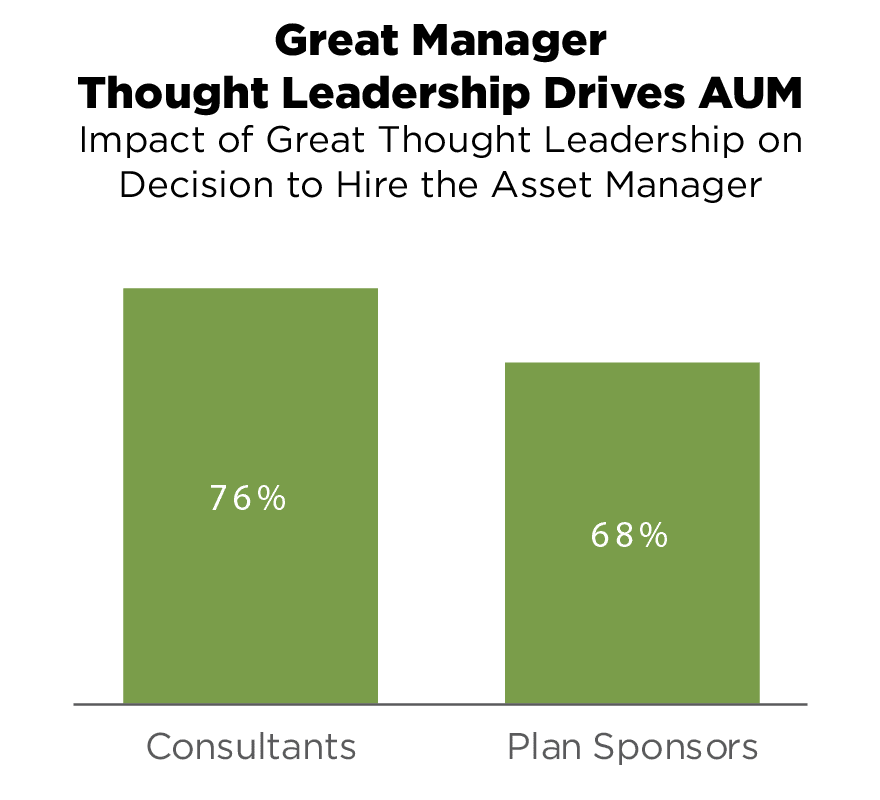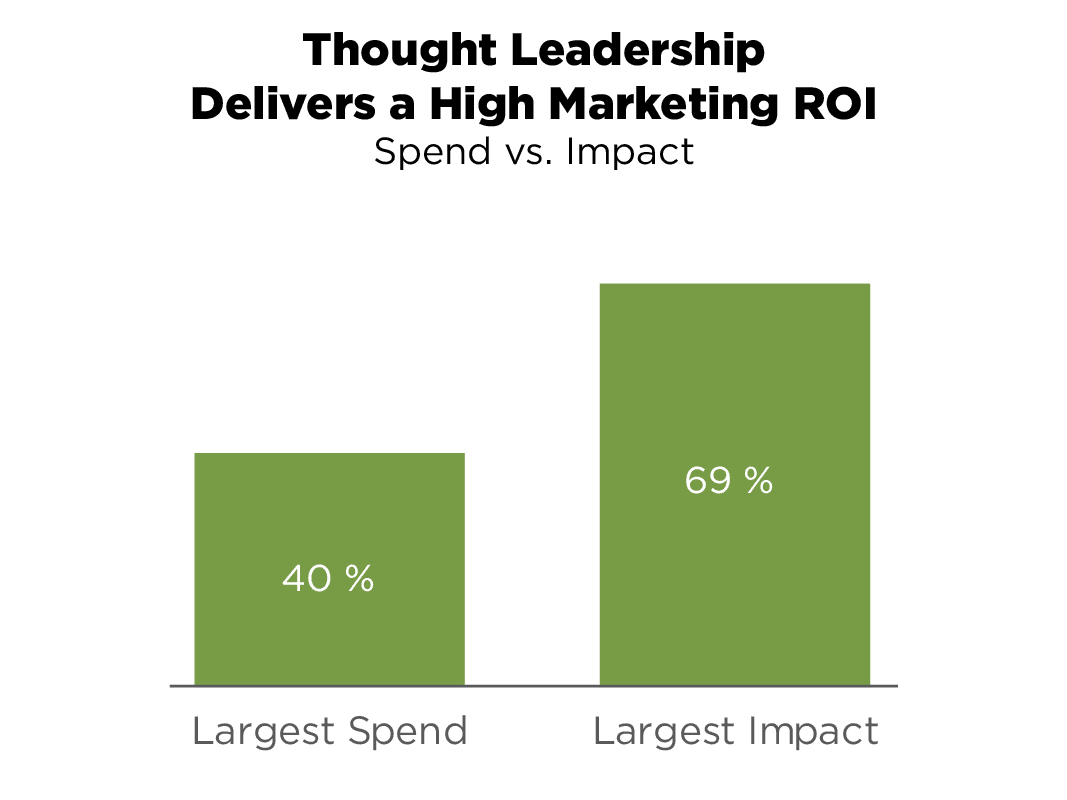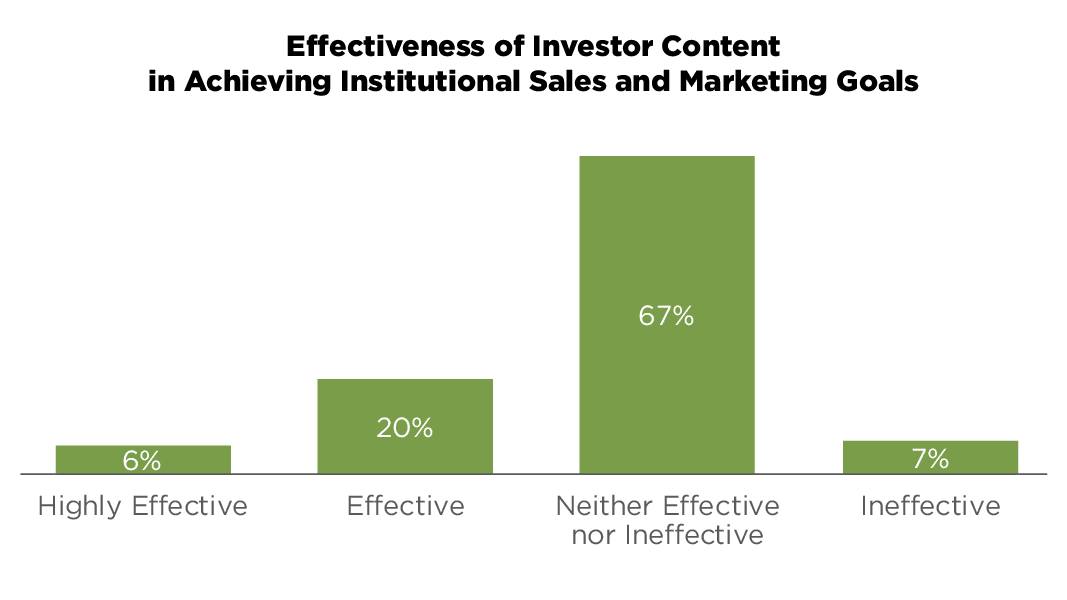Severe disruption across the asset management industry is driving managers to pursue new distribution strategies. Our research indicates that the most successful asset managers are taking an increasingly marketing-led approach to distribution.
Institutional marketing is taking more responsibility for driving asset managers’ growth. In our latest research, over half of senior institutional marketers report their role has broadened over the last five years, while none report any narrowing of their role’s scope.
Institutional sales and marketing teams are increasingly working in parallel. This is a marked change from the traditional approach where marketing served primarily a sales support function. As a result, reporting lines have changed, with 13% of institutional Chief Marketing Officers now reporting directly to the CEO/COO.
Creating impactful thought leadership generates the highest ROI of all institutional marketing efforts, according to our research. There is substantial room for managers to improve their thought leadership, as only 21% of institutional marketers in our survey feel their current content is very effective in helping achieve their institutional sales and marketing goals.

Institutional Marketing Moves into the Spotlight
Asset managers are reacting to severe disruption across the industry by pursuing new distribution strategies. Our research among the heads of institutional marketing at asset managers indicates that the most successful asset managers are taking an increasingly marketing-led approach to their business development efforts.
Institutional Marketing Is Gaining in Stature
At many asset managers, institutional marketing has become an equal partner to distribution. Gone are the days where institutional marketing’s primary role was to provide sales support or, worse, was siloed within the organization and had little to no strategic alignment with distribution.
More than half of the senior institutional marketers we surveyed say the scope of marketing’s role within their organization has significantly broadened over the last five years (see below). Similarly powerful, in our view, is the fact that during a period of declining margins and recurring resource cuts across the asset management industry, not one institutional marketer reported any narrowing of their mandate.

Institutional Marketing and Sales Are Increasingly Aligned
A full 100% of the senior institutional marketers we spoke with say their marketing plan is now created in conjunction with the institutional sales plan. As the institutional sales and marketing partnership has improved, reporting lines have changed. Less than half of institutional marketers we surveyed report to the head of sales today, while 13% now report directly to the CEO/COO.

Institutional Marketing Budgets Are Growing
Despite substantial cost-cutting efforts across the industry, one of the consistent themes we heard from senior institutional marketers is that institutional marketing spend is growing in the 5-10% range on average. The largest spend focuses on attendance at investor conferences and proprietary investor events. Some managers have even doubled their conference budget for 2019.
Asset managers believe these events provide a high return on investment because attending investors are certain to meet the firm’s senior representatives and will hopefully hear the firm’s message. Fully 80% of senior institutional marketers we spoke with rated sponsoring and attending institutional conferences as having the single highest impact on their AUM. Not surprisingly, conferences are also the area of highest marketing spend for 67% of these firms.
Great Thought Leadership Drives AUM with Lower Spend
Thought leadership is one of the most powerful tools in an asset manager’s marketing arsenal. For example, our research shows that almost 80% of consultants view great thought leadership as an important factor in their decision to hire an asset manager.

Thought Leadership Punches Above Its Weight in AUM
Senior institutional marketers understand the impact of thought leadership on their growth goals, ranking it the second most impactful marketing effort. Asset managers’ investment in thought leadership is not in line with the impact, however, with only 40% saying thought leadership is a top spending item.
Manager Thought Leadership Strategy Becoming Less Investor-Led…
Today 57% of senior institutional marketers tell us their thought leadership program is led by an editorial board consisting of professionals from marketing, sales and investments. This is a far cry from common practice prior to the severe disruption of the past decade, when thought leadership was largely driven by the interests or ideas of the investment team, with little to no input from marketing or distribution. Nonetheless, thought leadership is still created ad hoc across the organization by 36% of the firms with which we spoke.
…Although Marketers Feel Most Investor Content Still Isn’t That Effective
Only 7% of the senior institutional marketers we spoke with rate their own investor content as highly effective. This is not surprising to us, for several reasons. First, creating an effective thought leadership effort is difficult. It requires significant coordinated effort across many different teams (marketing, investments, distribution and compliance), a long-term strategic plan, and thought-provoking, sophisticated intellectual content that speaks to investors and reinforces that manager’s value proposition. In addition, most of the content produced by asset managers, in our view, is primarily descriptive in nature. Descriptive content without unique or provocative insight is generally perceived as just another drop in the asset manager “sea of sameness.”


Common Denominators of Great Thought Leadership
Just as there is no single best way to build a successful investment process, there is no silver bullet for creating great thought leadership, particularly since the definition of “great” depends on investor perception. Nonetheless, our research has identified common elements of asset manager thought leadership that most investors and consultants consider to be valuable (summarized on the right).
Institutional Marketing’s Influence Will Continue to Grow…
As institutional marketing efforts are increasingly important to asset manager growth, we expect the role will continue to gain responsibility and influence. Over the next few years it will no longer be novel to hear that marketing and distribution are fully equal partners in driving asset manager business development strategy and tactics.
…Along with Increased Investment in Great Thought Leadership
As the severe disruption impacting the industry shows no signs of abating, we also expect that great thought leadership will remain one of the most impactful contributors to manager AUM growth. We expect to see the most successful asset managers continue to invest more resources toward this highly effective, albeit difficult-to-create marketing tool.
Key Elements of Great Manager Thought Leadership
Thought-Provoking, Even If Wrong. Investors tell us the ability to demonstrate independent thought is the most important factor in positioning a manager as a great thought leader. A great thought leader provides a differentiated, forward-looking point of view, not a recap.
Relevant. Investors value insight where the manager is deemed to have expertise (e.g., long-term REIT analysis from a real estate manager) and skip material viewed as generic (e.g., a macro recap from an active equity manager).
Keep It Clear, Crisp… Great thought leadership has a clear message that is easy to understand. Investors increasingly “scan” manager material first to decide whether or not they want to invest the time to actually read it, so executive summaries, frequent descriptive headlines and strong graphics all help make thought leadership impactful.
…and Concise. A short piece can be more difficult to create than a longer article, but brevity increases the chance that investors actually read it. Investors tell us they want thought leadership that is short, sweet and to the point.
